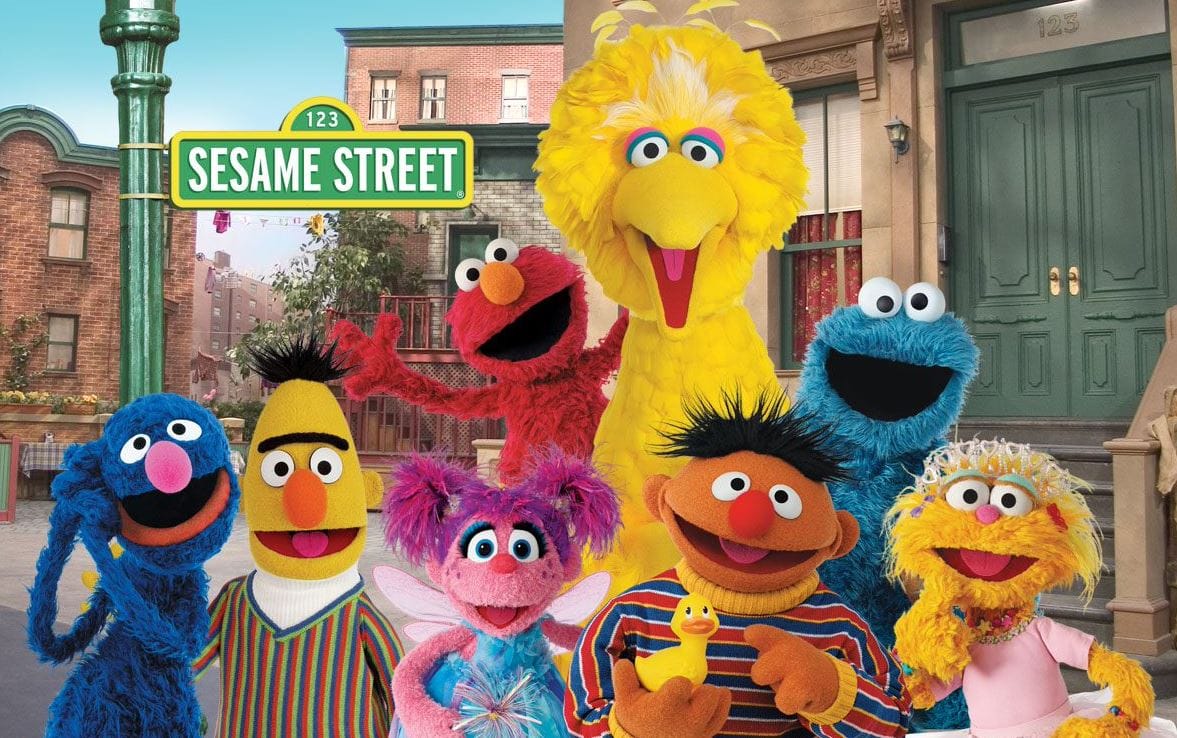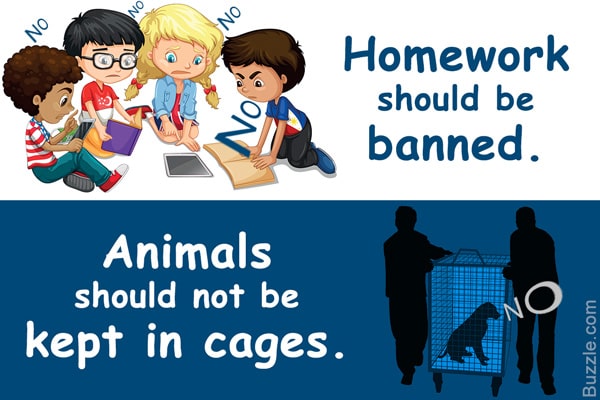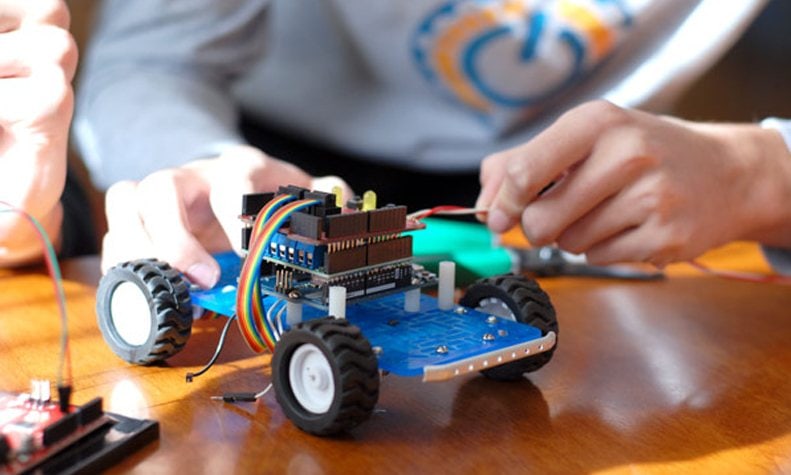Pets can be a great learning opportunity for children. They help develop compassion and empathy for living creatures while also teaching valuable life lessons. As a bonus, children with some types of pets are less prone to certain health issues than children without pets, and are also less prone to allergies later in life.
A pet is often your child’s first confidante. They build confidence for children who are lonely or are experiencing emotional distress with their ability to provide unconditional love free of judgement. Without question, your child will remember their first childhood pet fondly and the experiences they shared.
Pets can be a huge responsibility so it’s important to think about the pros and cons of each type of pet and how they can successfully fit in with your family. With all pets, you are ultimately the one responsible for the animal which is another important consideration when deciding on whether your child is ready for a new little friend.
Dogs

Why?: A dog can be a great addition to the family: they’re loyal, playful, and typically gentle with the youngest of hands. Each breed has a different temperament, so you’ll surely be able to find one suitable to have around children. Some suggested dog breeds for kids are Beagle, Golden Retriever, Labrador Retriever, and Boxer.
Average Lifespan: The average lifespan of a dog is between 10-13 years depending on the breed. While we would certainly want Fido to stay with us forever, this is ample time for your kiddo to develop a special bond while working on their social skills, sense of responsibility, and physical activity.
Caring for a Dog: For happy and healthy lives alongside your child, dogs should be fed premium-quality dry food and receive daily exercise for stimulation and burning calories. Dogs should be spayed/neutered and receive annual veterinary care and vaccinations. Depending on the age of the dog you might need to commit extra time to training to avoid undesirable behaviors, and some dogs may need a little extra help warming up to younger folks. While you will be responsible for most of the dog’s care, your child can assist with feeding, basic grooming, and playtime.
Best to avoid if… Dogs require a lot of attention and time so if your family is busy or away from home a lot, you might be better suited for a lower maintenance pet. Allergies should also be considered, as dogs can be a common trigger for kids and parents alike.
Cats
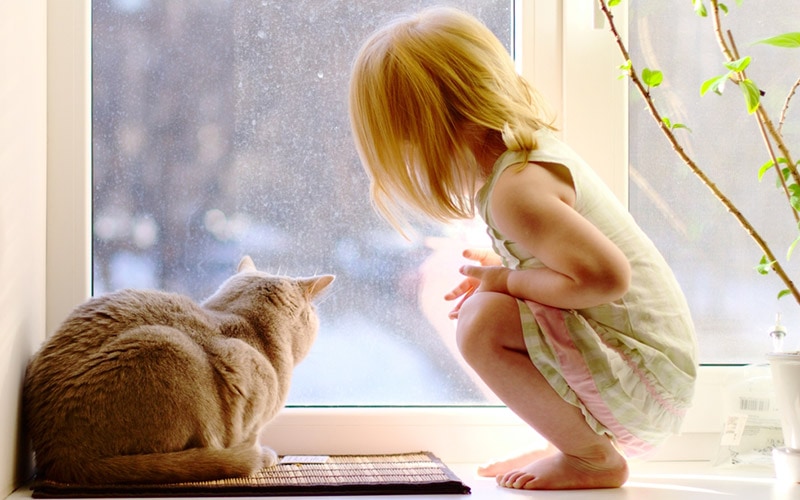
Why?: If dogs are a bit too high maintenance for you, cats are a great alternative. They are often affectionate and playful with kids, but independent and don’t require as much training as a dog. Your child might even feel safer around a cat because of their small size.
Average Lifespan: The average lifespan of a cat is around 15 years. In this time, your child will learn social skills, how to cope with difficult situations, and how to be patient as they wait for their feline friend to be ready to play.
Caring for a Cat: To live healthy lives, cats should be spayed or neutered and receive annual veterinary care and vaccinations. With guidance, your child can help with daily litter box scooping, playtime, and what to do when your cat thinks the brand-new sofa is a scratching post.
Best to avoid if… Like dogs, cat dander and saliva are common allergens. If you suffer from allergies, you’ll just have to get used to taking medicine, suffering from the symptoms, or choosing a different pet. It’s going to be very difficult for a child to bond with a pet that they’re allergic to.
Rabbits
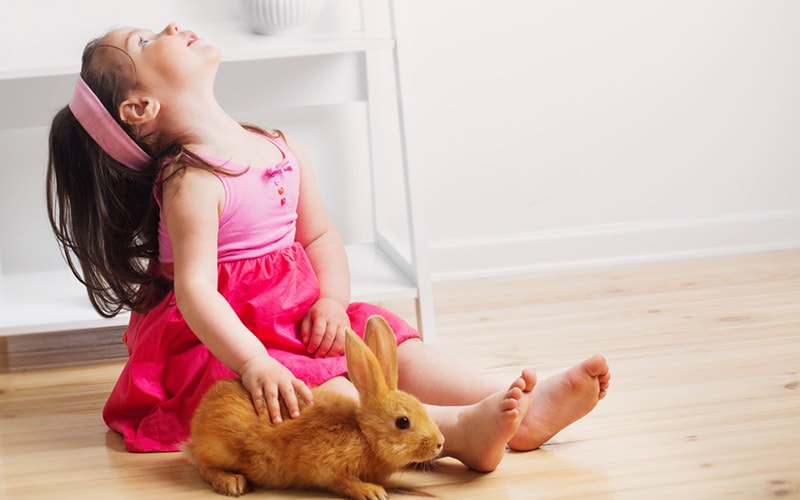
Why?: Rabbits are social and lovable pets, making them a great choice for children. They’re also very cute and soft, so they aren’t a very tough sell as an alternative for families that can’t have dogs or cats.
Average Lifespan: The average lifespan of a domesticated rabbit is between eight and ten years. It takes time to build a relationship with most rabbits but it’s worth it as children learn patience, determination, and the importance of giving animals space.
Caring for Pet Rabbits: Rabbits require daily exercise and enrichment through toys and socialization. Their diet includes a mixture of hay, pellets, vegetables and fresh water daily. Some veterinary care may be required, and spaying/neutering is recommended. As rabbits are usually more fragile than a cat or dog, it’s important to make sure your child is supervised or old enough to understand how to handle a rabbit.
Best to avoid if… If you don’t have a “bunny-proofed” area in your house, as rabbits are quick to chew anything they can get their teeth on, including children’s toys and videogames. Hay is a staple in a rabbit’s diet, so this should be considered if anyone in your family has an allergy.
Guinea Pigs
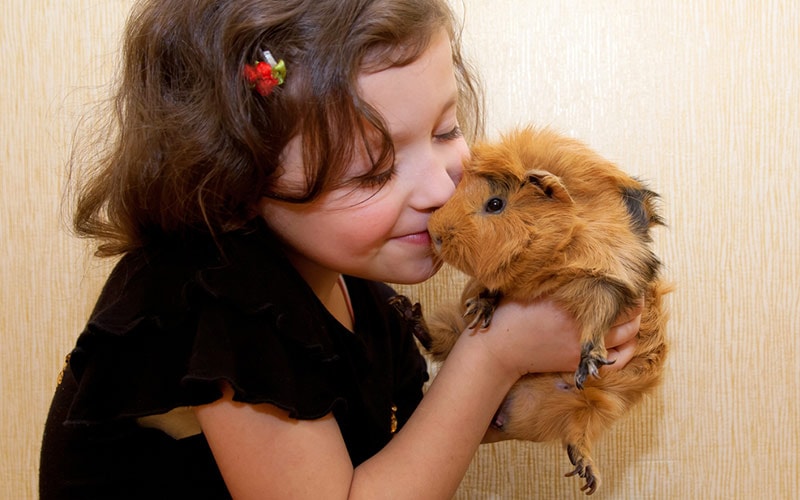
Why?: Guinea pigs are a good option for children because they’re social and amusing to watch! Children will delight in watching them chirp, purr, and “popcorn” (a term used to describe springing into the air when happy.)
Average Lifespan: The average lifespan is five to seven years, which is plenty of time for a child to form a great bond with their guinea pig, but also less of a life commitment than a dog or a turtle.
Caring for Guinea Pigs: Guinea pigs should be kept in pairs, so make sure your child understands that it’s twice as much responsibility to care for two. Like rabbits, guinea pigs will require time out of their cage to burn energy and for enrichment purposes, which is great for kids who also have a lot of energy for playing.
Best to avoid if… Your child won’t be able to interact and play with them often, since they require exercise and socialization every single day.
Hamsters
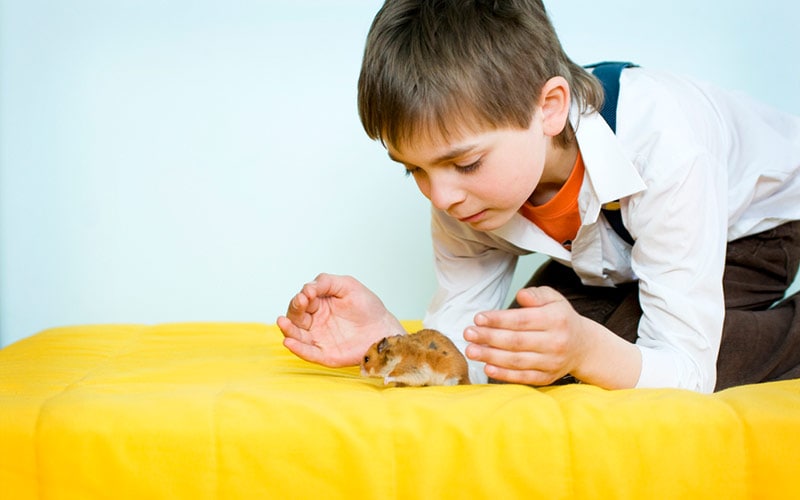
Why?: Hamsters are a great option for kids because they are low-maintenance when compared to cats and dogs and don’t need a lot of room (if they have an exercise wheel!) Their small size makes them easy for most children to handle on their own but like with a lot of pets, young children should be supervised.
Average Lifespan: The average lifespan for a hamster is between two and three years. This is on the shorter side as far as most pets go, making hamsters a better choice if you want to give your child the experience of having a pet without the lengthy commitment.
Caring for Hamsters: Hamsters need food and water daily as well as an exercise wheel to burn off excess energy. They need places to hide and bedding suitable for burrowing in their cage. Ensure your child can handle daily cage cleanings prior to bringing home a hamster because they can be very messy.
Best to avoid if… Your children are too young to handle them carefully. Hamsters are delicate and can be frightened easily. It’s important to note that hamsters are nocturnal animals making them loud roommates for sleeping children.
Rats
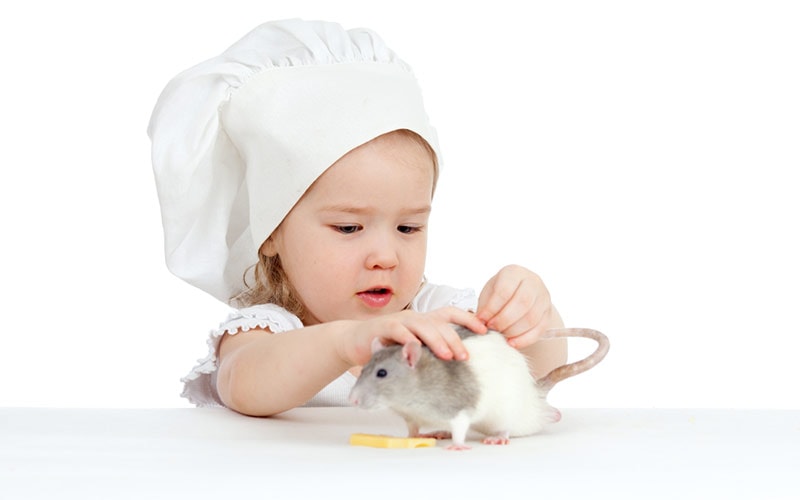
Why?: Contrary to popular belief, rats are clean and social creatures that thrive from human interaction. These traits make them a great option for kids!
Average Lifespan: Domesticated rats can live up to four years of age. This is like the lifespan of a hamster, but rats might be a more interesting choice for your child due to their friendly nature and ability to learn tricks.
Caring for Pet Rats: Rats require a large enclosure with space to run, play, and hide, and time outside of their cage as well. Rats eat a diet of dry formulated rat pellets, fresh fruit and vegetables, and water daily but they’ll also love it when your child offers them treats. Like guinea pigs, rats need to live in groups of at least two so it’s important that your child can handle the responsibility of two pets. Children should expect to clean their cage twice a week and spend around an hour a day socializing with them. Rats are susceptible to upper respiratory infections and might require veterinary care from time-to-time.
Best to avoid if… Your children are young, as rats have long tails that can be easily damaged if pulled on.
Fish
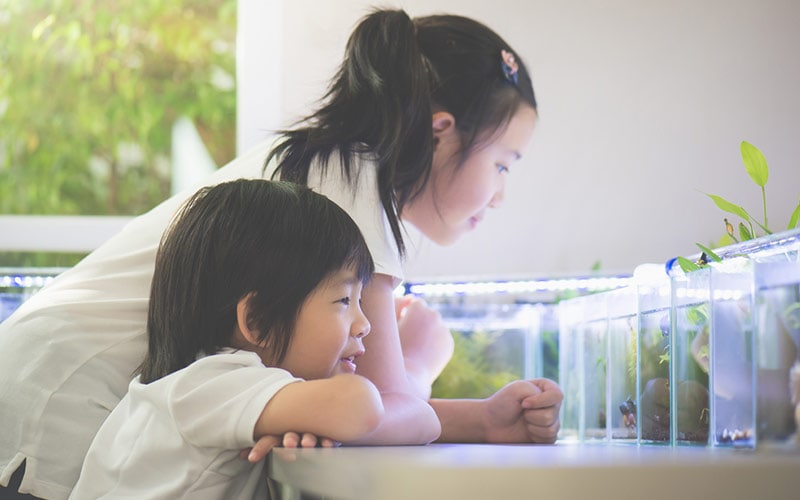
Why?: Fish can be great pets for children because they are relatively inexpensive when compared to our canine and feline friends, and don’t require a lot of maintenance once the aquarium is established. You also won’t have to worry about noise that keeps you or your children awake, litter boxes, or having to take them for a walk after a long day when your child has homework or another convenient excuse.
Average Lifespan: The lifespan of a fish depends on a variety of factors such as the size of the fish and their environment’s conditions, including how well your child cares for them. Tropical fish species can live between three and five years. Goldfish and koi can live much longer – between 20 and 40 years! For children, tropical fish are probably the way to go because of their shorter lifespans and typically less demanding space requirements.
Caring for Fish: Compared to some pets, fish can be considered low maintenance. They only require your child to give them a little bit of food everyday and weekly water changes dependent on the size of your aquarium. Older children can learn about the nitrogen cycle and how to test for ammonia, nitrate, and nitrite levels in the aquarium.
Best to avoid if… Even though fish can make great pets, there is a lot of work involved with setting up an aquarium. Aquariums must go through a process involving the nitrogen cycle prior to adding fish – this can take up to 8 weeks. While this is a great opportunity to learn about Chemistry, it isn’t for everyone. Your child may lose interest or not develop as much of a bond with fish, since they’re certainly not the most interactive pets.
Lizards
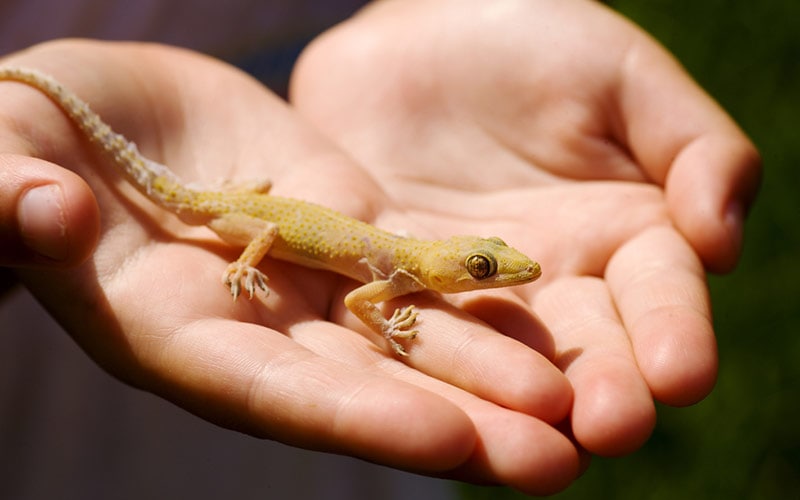
Why?: Lizards are a unique pet that are low-maintenance, making them the ideal pet for the busiest family. Some species, such as the bearded dragon, are considered very gentle and docile which is important when it comes to children!
Average Lifespan: The lifespan of a lizard is typically between 10-40 years dependent on the species. This could be a significant commitment so be prepared to take on ownership once your child transitions to college.
Caring for Lizards: Feeding and habitats will differ between types of lizards, but you will never have to worry about grooming or devoting a lot of time to exercise and socialization. This makes lizards a better option for children with busier schedules or allergies to furry animals.
Best to avoid if… You have young children as lizards need to be handled gently. Lizards can also be a long commitment due to the typical lifespan of most types, so this should be considered prior to bringing your new friend home.
Tropical Turtles
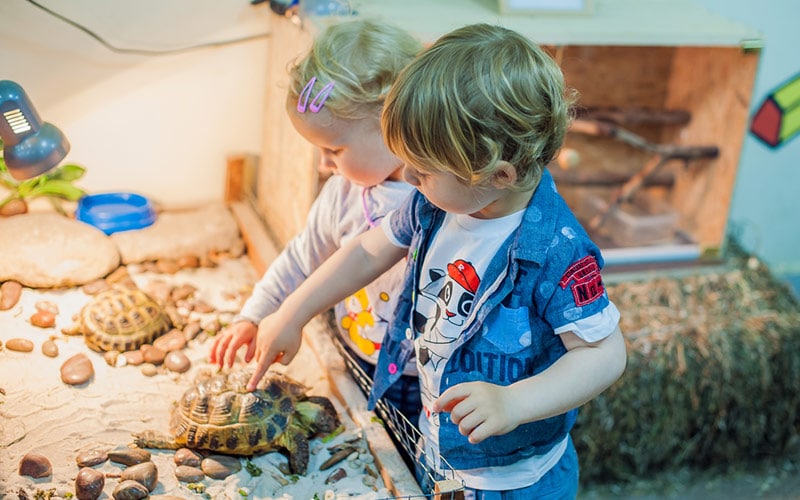
Why?: After initial setup, turtles are a low-maintenance option for children. They’re intelligent and can be taught basic tasks. They are ideal for children who suffer from allergies to cats, dogs, and other furry friends.
Average Lifespan: If properly cared for, turtles can live up to 40 years. Like lizards, this might be too long of a commitment for most children.
Caring for Turtles: Tropical turtles need a warm environment and humidity. This might mean adding a heat lamp to your turtle’s setup. They require a lot of space (a 5-inch turtle needs 50 gallons!) so they may not be ideal for kids with smaller bedrooms. They also need an area to swim within the enclosure, and some rocks. Their diet is mostly carnivorous: grasshoppers, snails, and freshwater shrimp. Caring for a turtle is a great opportunity for children to learn about different types of animals and how their needs differ from those of humans.
Best to avoid if… Anyone in your family is susceptible to illness as turtles are known to carry the salmonella virus in their shell. Turtles can also be a lengthy commitment when compared to other options.
Birds
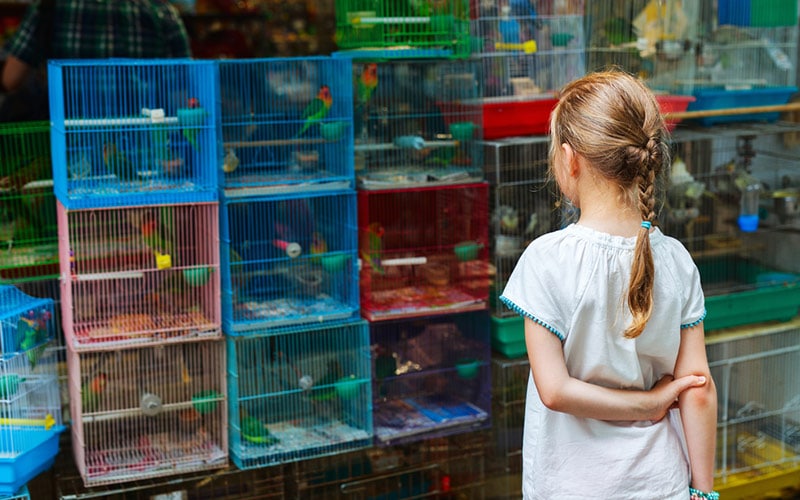
Why: Birds are a good choice for kids if allergies are a concern. They are also interesting to watch and listen to with their chirps and singing. Recommended species to have around kids are cockatiels, finches, and budgies.
Average Lifespan: The lifespan of a bird can be anywhere from 5-80 years depending on the species of bird. For a child, it might be a good idea to stick to species with shorter lifespans or another type of pet if you aren’t willing to take on full responsibility down the road.
Caring for Birds: Birds require a diet of pellets, seeds, vegetables, fruits, and fresh water daily. They don’t have heavy grooming requirements apart from regular nail clipping and light misting with water once or twice a week. Before getting a bird, children should show that they are responsible enough to handle cleaning the cage and replenishing food and water daily.
Best to avoid if… Your children are young as some birds startle easily from loud noises leading to premature death. Some species of birds should be avoided if you are unsure of the long commitment.
Final Thoughts
It’s good to involve your child in the decision. You can make a shortlist of a few options that suit the needs and lifestyle of your family and see which one appeals most to your child. By having input in the decision, they’ll be more likely to form a bond with the pet, and keep up with all of the necessary care.


